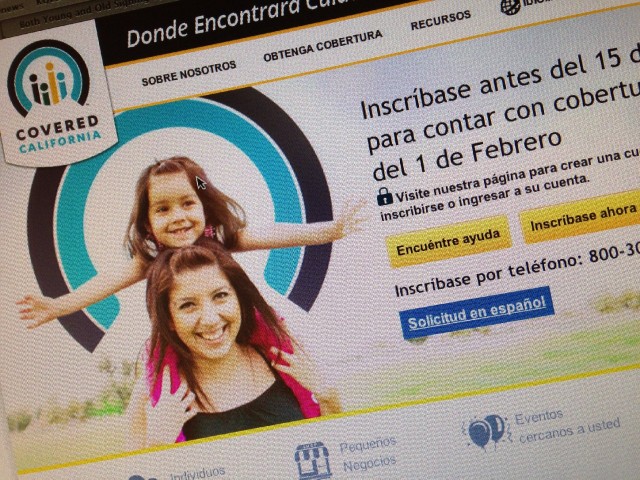Many Latinos have never bought insurance before. So Bobadilla takes the time to explain what the benefits are and how they work, in their own language: Spanish.
Bobadilla is exactly the kind of person Covered California wants in the trenches. The trouble is, there aren't nearly enough people like her out there. The state wanted to have 20,000 certified counselors ready to go when plans first went on sale in October. Yet today, it has just 4,000.
There are several reasons for the shortfall. Political wrangling at the federal level delayed the rollout of training programs. That meant there wasn't time to approve a Spanish curriculum or a Spanish certification test. So many qualified counselors like Larissa Bobadilla had to take their chances in English.
“I feeling so nervous, feeling so—frustration,” she says. “It's so hard when it’s in another language.”
She passed the test. But other promotoras in the community didn't, and they can’t help anybody until they do.
Compensation Too Low?
Money has been another problem. The state relies on community nonprofits to recruit and train enrollment counselors like Bobadilla. But the state only pays $58 for each person a counselor enrolls -- and then only after a customer pays the first month's premium. Many nonprofits say that’s not enough to cover the actual costs of training counselors and giving consumers all the help they need.
“It’s not just about enrolling people, you have to educate them,” Sonya Vasquez, policy director at Community Health Councils. “And then because they built that relationship with you, if there’s something that happens, they’re going to come back to you and none of that is actually getting paid for.”
The shortage of people power isn’t just limited to the streets. Covered California underestimated how many counselors it would need to staff its call centers. Many people who asked to speak to someone in Spanish got transferred to English-speaking agents. When there are too many calls, the system simply hangs up.
The website has had similar problems.
"I visited the website, with my brother’s help, and we tried to enroll, but it didn’t work,” says Maria Aurelia, a teacher from San Pablo, east of San Francisco. She went to an enrollment event at her local library. “I prefer to sign up face-to-face. Fac-to-face, there’s better communication.”
All these steps require a lot of effort. So it should be no surprise that the number of Latinos who have actually signed up for a plan through Covered California is extremely low.
Suspend Advertising Campaign -- or Keep Going
State senator Norma Torres is exasperated. She says the economics of the system depend on Latinos, who, as a group, are younger and healthier than the population as whole. Their premiums will help keep costs down for everyone else. Torres is frustrated that her office has been flooded with calls from Latinos who want to sign up but can’t.
“What is the message they’ve received? Keep trying. Keep calling,” Torres said at Covered California’s January board meeting. “What business would say to consumers who want their product to keep trying? To not give up? We need to do better.”
She’s urging Covered California not to spend any more money on advertising until it improves its customer service operations. But executive director Peter Lee says he won't give up on marketing.
“We are not going to take our foot off the gas in raising awareness and getting people to knock on our door. It’s our job to make sure when you knock, we answer the door,” he says.
But marketing experts say the disconnect between the hype and reality is yet another reason Latinos aren't signing up. People hear from their friends about bad experiences trying to use the system, but then they see TV commercials that say it's easy to enroll and affordable plans are within everyone's reach.
“It’s almost defrauding the consumer,” says Carlos Santiago of Hispanic market research firm Santiago Solutions Group in Los Angeles.
He says these ads further erode the trust of Latino communities.
“It’s building this greatness, greatness, greatness, greatness,” he says. “In fact, you go into doubt, your mind goes like but that’s not true, that’s not true. Why should I call?”
Santiago says affordability is the greatest hurdle. Despite the ads, people still don't understand that they may qualify for subsidies that will bring monthly payments down, or that they might be eligible for free coverage through the state's Medicaid program. But even then, there's still a big problem with price sensitivity.
Many Latinos grew up without health insurance, and haven't considered buying it before now. Santiago says paying a couple hundred dollars every month for an average plan, just to have peace of mind, is not a convincing value proposition.
“You go wait a minute, am I going to use this right away? How much do I need that security right now, this year when I have all these other realities in my life to fit in my budget,” he says.
The threat of tax penalties may push some people over the edge, but others will decide that paying a fine will be more cost effective. Santiago's research shows that only a quarter of Latinos are willing to pay more than $100 a month for insurance.
So even if Covered California manages to come up with a brilliant marketing campaign and hire an army of customer service agents, there's still a problem of price point.
